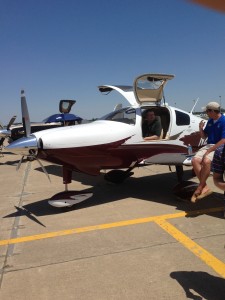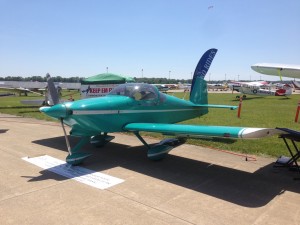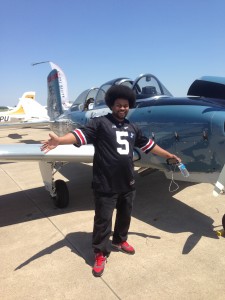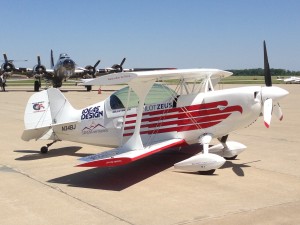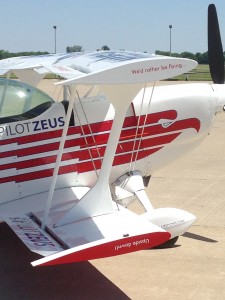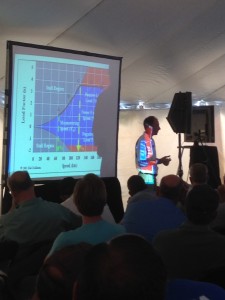Last weekend, I flew with two of my students to the Indianapolis AOPA fly-in. It was the first large-scale fly-in that I have actually flown myself to.
My dad and I used to fly in to pancake breakfasts when I was little, but I don’t really remember them well, and they were very small compared to these AOPA regional fly-ins.
But I knew, somewhat, what to expect. We were coming in from the east, and leaving Columbus, Ohio meant that navigation would be easy – turned out that the NOTAM said that incoming traffic from the east should arrive over Interstate 70 and follow it pretty much right to the downwind for runway 7, which happened to be the runway in use that day. It was also CAVU (ceiling and visibility unlimited) all day. Pretty much a perfect day for the fly-in to happen!
We flew out of Bolton Field (KTZR), one of the airports I instruct out of. Interstate 70 runs right through downtown Columbus, and you can pick it up upon departing Bolton almost immediately. So we did! We got flight following as soon as we had cleared Bolton’s class D airspace, and climbed to 6,500 feet for our westbound trip to Indy Regional (KMQJ). I was a little on edge right from the start, knowing that we were flying in the morning of the fly-in, and that that would probably be the busiest time to arrive all day.
I told both of my students that I would need their eyes, and that traffic would be pretty heavy the closer we got to Indianapolis. I’m not sure they believed me at first… but by the time we got within a few miles of the airport they sure did! One sat in the back of the Cessna 172 we rented, and the other sat in the left seat, with me in the right. In the back, my student tapped me on the shoulder and raised the number of fingers of the planes she had in sight behind us in the “conga line” over I-70. I think she had up to four by the time we were entering downwind.
KMQJ is a non-towered airport, so we were on our own from about 30 miles out when Columbus Approach said “Radar Contact terminated, squawk VFR.” This was prior to reaching a rest area on I-70 just west of Richmond, IN. Which I thought was an interesting idea – I have a hard enough time not missing Rest Areas when I’m in the car and need to pee. Good luck identifying one from above when everyone else in the sky is also converging on the same spot at the same time – or so it felt like.
The CTAF (Common Traffic Advisory Frequency) was pretty much lit up at all times from the time I switched over from Columbus Approach until we flipped the avionics master off for shutdown. I felt sorry for any other non-towered field that shared the frequency… they weren’t getting a chance to say much that day. It was also hard to determine who was where any given time. I heard calls saying “I think I’m number 5 on final,” and numerous “somebody on base cut off my final, going around” calls.
Organized chaos. Without as much organization as you would hope.
The NOTAM called for anybody coming in from the east to turn right base upon reaching a “split” in I-70 about two miles from the approach end of runway 7. Which we did. And immediately upon doing so, saw a plan on final right in front of us. No problem – they’d be out of the way by the time we got to the extended centerline for final. We also noticed about 3 more planes ahead of that one. That’s four (count ’em) planes on final within about 2 miles of the field. Busy.
But more importantly, we also saw at least three more planes BEHIND the one in front of us – “uhhh – I think I’m number 7 for the runway of the same number.” Yikes. We couldn’t find a gap to squeeze into, so I made a steep left turn and extended my downwind a little further, trying to communicate what I was doing at the same time.
We ultimately found a gap, made our turn, and ended up on final for 7. As we got closer, the S-Turns started. I had 10-degrees of flaps in, and started s-turning myself to make space, or at least not loase any space, between us and the plane in front of us – a low-wing something-or-other. Others behind us were s-turning as well, but we ultimately touched down behind the low-wing, who I thought was going to make the first turn-off (allowing me to land longer and give space to the plane behind me), but it didn’t. It rolled right past, where, as I followed with my eyes, noticed there was at least one more plane on the runway in front of him. So by the time I touched down, there were three of us still on the active runway.
I know at Oshkosh they land three at a time on the same runway, but in my head I’m thinking “runway incursion.” I’m also thinking – that guy behind me is probably close, too… and I had not added any more flaps – I was still at 10-degrees. So The lading was pretty good, until I decided I HAD TO MAKE THE FIRST TURNOFF and get off the runway ASAP – because of the guy in front of me who I thought should already be off, and also because someone was landing behind me and I wanted to clear the way.
BRAKES. SQUEAL. LEFT RUDDER. BACK ELEVATOR. TAXIWAY QUICKLY PASSING. And into the grass we went, right between to runway lights, JUST BARELY past the taxiway. Then slowly, embarassingly, taxiing back onto the taxiway, between two taxiway lights. Missed it by 10-15 feet at most. Never lost control of the aircraft at all, but definitely a bad judgement call to try to make that taxiway with everything else happening so quickly. But everything else happening so quickly was also WHY I made the call to try to make the first taxiway. A catch-22 if ever there was one.
I take some solace in the fact that I was certainly not the only one to have a bit of an issue coming into the fly-in. I heard about a Cirrus landing nosewheel first and smoking the tire a good length of the runway, and somebody else locking up their mains with heavy braking upon touchdown. I actually saw someone level off on final and fly OVER the person landing in front of them, and then landing in front of them anyway instead of going around (WHAT!?!). Yeah – that happened. But this is a learning experience, right? That day, it was a learning experience even for the teacher – and I hope my students learned something, too. We talked about it even on the taxi to parking immediately after, and I knew before I even rolled into the grass that I should have braked straight ahead and let the folks behind me decide whether to land or go-around.
Heck – If I thought the plane in front of me was too close, *I* should have gone around. But hindsight is 20/20 – in the heat of the moment, it was get on the ground and get out of this mess of traffic up here. Alternatively, we could have gone to the alternate airport and taken the shuttle in to the fly-in. Which is what I HIGHLY suggest you do if you are flying in the morning of. I certainly will next time.
Other than a learning opportunity and some slightly bruised pride, the fly-in was a TON of fun. My students and I learned about unusual attitudes (code for aerobatics) and attended a session on communications with Air Traffic Control (ATC). We also got to see some incredible airplanes, meet some interesting people, and learn about some fantastic organizations. And we got to fly in. How cool is that?
Below are some more pictures from the day – me and my students, in and around airplanes. Just can’t beat that.
Notice what the wingtips say:
Andrew Hartley is a certificated flight instructor and commercial pilot in Columbus, Ohio. This was his first (and hopefully last) excursion into the grass (other than at a soft field airport).
